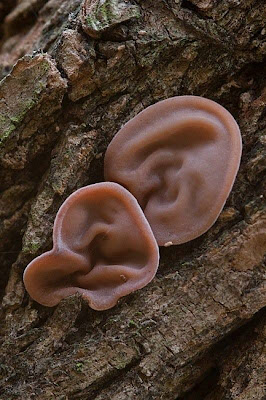Ever heard the saying that the walls
have ears? Perhaps the correct thing to say should be “the trees have ears”
according to these pictures. The ‘ear’ shown in the picture is the fungus Auricularia auricula-judae. It is also
known as Jelly Ear, Wood Ear, Jew’s Ear and other common names. The species was first described in 1753.
The fruiting body is distinguished by
its noticeably ear-like shape and brown coloration; it grows upon wood, especially
elder.
Its specific epithet (auricula-judae)
is derived from the belief that Judas Iscariot hanged himself from an elder
tree; the common name "Judas's ear" eventually became "Jew's
ear", while today "jelly ear" and other names are sometimes
used. The fungus can be found throughout the year in temperate regions
worldwide, where it grows upon both dead and living wood.
In the West, A. auricula-judae was used in folk medicine as recently as the 19th century for complaints including sore throats, sore eyes and jaundice. Today, the fungus is a popular ingredient in many Chinese dishes, such as hot and sour soup, and also used in Chinese medicine. It is also used in Ghana, as a blood tonic. Modern research into possible medical applications has variously concluded that A. auricula-judae has antitumor, hypoglycemic, anticoagulant and cholesterol-lowering properties.


No comments:
Post a Comment